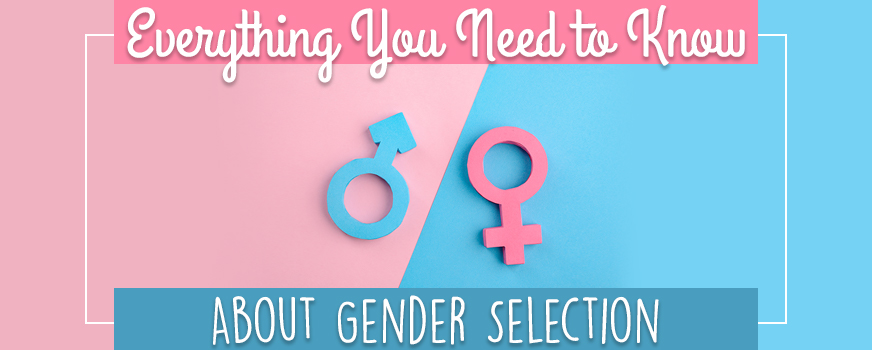
Like most would-be parents, you have probably spent quite a bit of time thinking about what life will be like when your little bundle of joy finally makes your dreams come true. You make lists of your favorite names and wonder whether you’ll be painting the nursery pink or blue. What if you had the opportunity to eliminate those questions by choosing the gender of your baby? Would you do it?
As a result of recent scientific advancements, these are no longer hypothetical questions. In the United States, gender selection is not only available, it’s completely legal. This is something that cannot be said about other countries, like Australia or Japan. However, simply because gender selection is available, does not mean it is the right option for every family. From how much gender selection costs to how gender selection works, the following facts should provide helpful information for anyone considering this option when building their family.
The Science Behind Gender
Before you understand how fertility gender selection works, it is important to have a basic understanding of genetics and how each parent’s genetic material works together to create a unique human being.
Women only produce “X” chromosomes; therefore, it is the father’s sperm that determines whether an embryo is male or female. If the father’s sperm contains an “X” chromosome, the resulting baby will be female with “XX” chromosomes. If the father’s sperm contains a “Y” chromosome, the resulting baby will be male – “XY.” For medical professionals, the process of selecting a child’s gender is relatively simple; however, it is rather difficult to select the gender of a child without medical intervention.
How Gender Selection Works
Currently, there is only one guaranteed method of fertility gender selection used during fertility treatment, and it is known as preimplantation genetic screening, or PGS.
Preimplantation Genetic Screening (PGS)
When using PGS for gender selection, fertility doctors provide a treatment to help a woman grow 10-12 eggs. Next, the fertility doctor extracts the eggs from the patient’s ovaries and fertilizes them in the lab. The resulting embryo is then placed inside an incubator and left to mature for 5 days.
After the 5 day period is over, a biopsy is performed on the embryos and the samples are sent for testing to a genetics lab. The genetics lab is able to determine not only the embryos gender, but whether the embryo is chromosomally normal and the overall health of the embryo. Based on the results from the genetics lab, the ideal embryo is then chosen and returned to the womb using in-vitro fertilization (IVF).
Success Rate
Although this fertility gender selection is 99.9% effective in producing the correct gender, it is important to remember there is always a chance you won’t become pregnant when you use IVF. Your success with IVF depends on several factors, including your age and health. The overall success rate of IVF is a little over 22%, though that number tends to be higher for younger women.

Reasons for Gender Selection
There are almost as many reasons for fertility gender selection as there are people who want to become parents. Some of the main reasons people decide on gender selection are personal, social, and culturally based. It is important to remember; however, that on average, an IVF cycle that includes PGS for gender selection runs between $12,000 and $16,000, making it clear those who decide to select the gender of their children do so because it is very important to them.
Personal Reasons
Imagine you have been trying to become pregnant for several years and you are in your late 30s. You’ve finally decided to try IVF, which your insurance doesn’t cover. If you don’t have enough money saved, or time available, to try the procedure again in a few years, you know that this is probably your only chance of having a child. As the only child of a single mother, you’ve always dreamed of having your own daughter to raise, and you want to follow in your mother’s footsteps. You might decide on choosing the gender of your baby as part of your IVF treatment.
Imagine you had a young son who passed away or you miscarried a pregnancy with a boy before your current round of IVF treatment. Though another son could not replace the one you lost, having another boy might satisfy some of your longings. In this case, you may consider fertility gender selection.
Social and Cultural Reasons
In developed Western countries, such as the United States and Australia, most couples who choose gender selection do so for reasons of gender balance. In other words, parents want families with both boys and girls. They want to provide their children with siblings of both genders, and they want the chance to raise both sons and daughters. For example, if you already have two daughters, you might want to balance your family dynamic by adding a son. You might feel your daughters would benefit from looking after a little brother and that it would help them relate to both genders as they grow up.
In some countries, where overcrowding is a problem, and parents are urged or required to limit the number of children they have, they may face tremendous cultural pressure to have a child of a certain gender. For example, in China and India, many parents face societal pressure to have a son. In fact, because fertility gender selection is illegal in many other countries, some couples travel to the United States to take advantage of the opportunity to choose their child’s gender.
Medical Reasons
Some genetic conditions are passed along through sex chromosomes. Diseases including hemophilia, cystic fibrosis, Huntington’s disease, and muscular dystrophy are only a few genetic conditions that can be passed with either the “X” or the “Y” chromosome. If you know you or your husband carries a genetic disorder, you may want to choose the gender of your baby to prevent them from being affected by such a serious condition. It is important to note many of the countries that ban gender selection allow it for medical reasons such as these.

The Gender Selection Debate
Supporting Argument
Although fertility gender selection is both possible and legal in the United States, not everyone agrees this is the way it should be. Those in favor of gender selection argue it can help parents who are looking to balance their families with both sons and daughters. For parents who face societal, cultural, and familial pressure to have a child of a certain gender, gender selection advocates say the process could prevent abortion, infanticide, and child abandonment.
Opposing Argument
On the other side of the debate are those who worry gender selection for non-medical reasons will increase sexism, worldwide gender imbalance, and racism or other forms of intolerance. Many fear that allowing the process brings the world one step closer to one in which “designer babies” are the norm. If parents are able to choose a child’s gender, they argue, soon they will be able to choose hair color, eye color, and other traits as well.
If you’re excitedly waiting to start a family, it’s likely your future child’s gender has crossed your mind. You might relish the idea of being surprised, of waiting until the doctor (or ultrasound technician) says, “It’s a girl (or boy)!” Or, your future child’s gender might be a source of more anxiety than joy – especially if you know that you carry a genetic disease or raising a child of a particular gender would be hard for your family.
No matter where you stand in the debate, Red Rock Fertility’s compassionate staff of knowledgeable medical professionals are happy to discuss fertility gender selection options with you, whether your questions are based on a medical or ethical concern. Until then, just remember our world is a diverse one. You can draw comfort in knowing there is an option out there that will work for you and your family.



